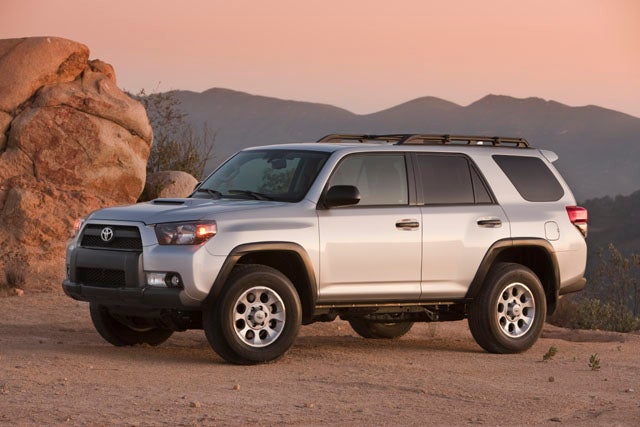 |
| For the fifth-generation 4Runner, Toyota is offering a new Trail version with unique off-road features. |
Toyota’s 4Runner just turned 25, and to mark the occasion the company is offering a new fifth generation of the popular off-road-capable SUV for 2010. Toyota launched the new 4Runner to the press recently at an event in Central California where we were able to test drive the new vehicle in a number of different trim packages.
One of the biggest changes to the new 4Runner is Toyota’s decision to move away from a V8 engine. The company has turned to an improved 4.0-liter V6 motor that is rated to produce 270 horsepower with 278 ft-lb of torque. This is 34 more hp than the previous V6 and 10 more than the previous V8. Horsepower and torque gains aren’t the only benefits to the new 4.0-liter engine, as the new power plant also offers improved fuel economy, with much of this coming from new engine management such as Toyota’s use of dual independent Variable Valve Timing with intelligence (VVT-i). The MPG rating is 17 city and 22 highway for the 4x4 version (up from 16 city/20 highway), and 17 city and 23 highway for the two-wheel-drive version (up from 16 city/21 highway).
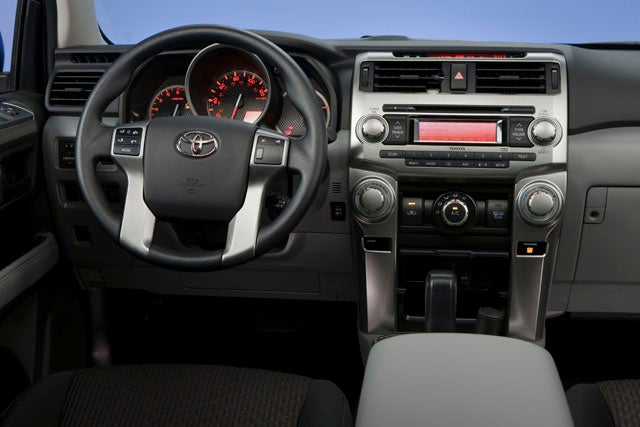 |
| The new outside styling is matched with a new interior design for the 2010 4Runner. |
There will also be a 2.7-liter 4-cylinder model available, which is an option for buyers looking to have a lower purchase price (though this seems to be the main benefit since the mileage improvement is slight). The motor produces 157 horsepower and offers a little better fuel economy for driving around town with an EPA rating of 18 MPG in the city and 23 MPG on the highway.
The 2010 4Runner will still utilize a body-on-frame design as in years past, and it actually shares the same platform as the FJ Cruiser. There are both 2WD and 4x4 options, and there are three different trim options that include SR5, a new Trail version, and Limited.
There are a few specific features off-roaders will be interested to hear about on the new 4Runner. Toyota’s A-TRAC system is now standard equipment on all 4x4 models, helping to distribute driving force to any one wheel on the ground for improved traction. Toyota also equipped the fifth-generation model with a stronger rear differential, as the gear ring is increased from 7.87 inches to a larger 8.18-inch gear.
 |
| Toyota has moved away from the V8 on the 4Runner, but that doesn't mean the 2010 models don't have a motor with some juice. The new V6 produces 270 horsepower and has a tow rating of 5,000 pounds. |
The new Trail version of the 4Runner is designed to offer a number of features geared specifically toward off-road use. First off, an electronic locking rear differential is standard equipment on the Trail. A new feature only available on the Trail model is Crawl Control, which is a system that controls certain aspects of the vehicle’s operation in low gear so the driver can focus on, well, driving. The system features five different speed settings to regulate engine speed and apply breaking force when driving on rugged terrain up or downhill, and it can only be engaged when the vehicle is in the low gear. Once in low gear, system is controlled via a knob on the overhead console near the rearview mirror.
Though Crawl Control is only available on the Trail version, all other 4x4 models are equipped with Downhill Assist Control (DAC), which will regulate the vehicle’s speed (but not braking) during downhill descent when in the low gear. This option isn’t on the Trail version since the Crawl control offers much more for both up and downhill situations.
PAGE 2
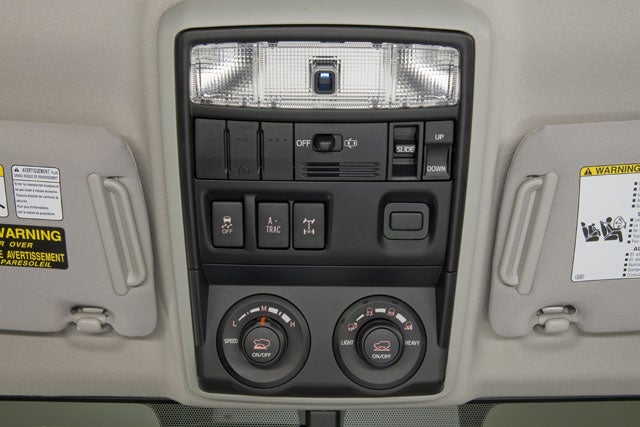 |
| These are the controls on the Trail model, with Crawl being the left knob and Multi-Terrain Select the knob on the right. The locking rear differential, A-TRAC and other functions are controlled here. |
Just next to the Crawl control on the Trail model is another control knob to activate a new feature called Mutli-Terrain Select system. This allows the driver to control wheel spin based on the terrain. For instance, the setting for sandy or muddy conditions where wheel spin is desired to help control the vehicle will allow more spin. For solid rock or similar terrain, wheel slip can be minimized so that the system functions more like a limited slip.
Previously only available on the Land Cruiser but now an option on the Trail version (and only on the trail version) is Toyota’s Kinetic Dynamic Suspension System (KDSS). The system improves the vehicle’s capability on the rough terrain by disconnecting stabilizer bars to allow for more axle travel and improved suspension articulation.
Over 1.8 Million Sold
What has given the 4Runner such mass appeal over the years is its all-around versatility. While the 4Runner is a great vehicle to take on the trails, it’s also a very comfortable and confident on the paved road. Much of that comes the balance of suspension components that are both off-road capable and on-road comfortable. For the fifth-gen 4Runner, Toyota employs coil-spring gas shocks on all four corners, double-wishbone independent front suspension, and a four-link rear suspension. Toyota also equipped the 4Runner with new variable-flow rack and pinion steering to improve its on-road capabilities.
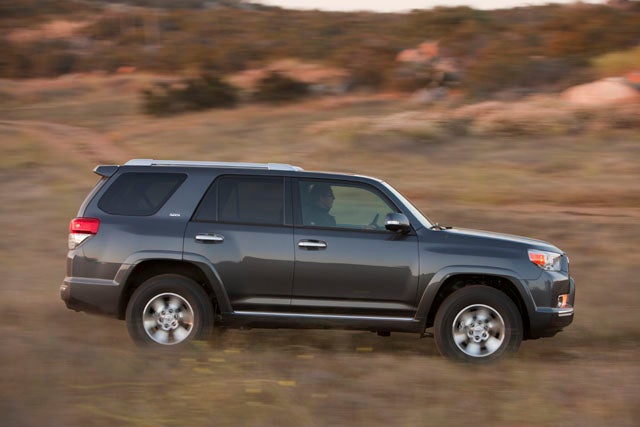 |
| The SR5 model, which Toyota representatives think will make up close to 75 percent of the 4Runner's sales, comes in 2x4 and 4x4 version, and there's a 4-cylinder version available in 2x4 as well. |
The 2010 4Runner also benefits from a number of acronym-labeled features that fall under Toyota’s Star Safety System (TSSS, and yes, it’s another acronym), such as Vehicle Stability Control (VSC) with traction control (TRAC), and Anti-Lock Braking System with Electronic Brake-force Distribution (EBD). For those going the 4x2 route, the standard Auto Limited Slip Differential (LSD) system helps provide improved traction. Hill-Assist Control (HAC) is standard on all V6 models, and it is designed to help reduce backward roll when moving from brake to gas starting from a hill.
There are eight standard airbags on the new 4Runner, including front, side-mounted and knee airbags for the driver and front passenger. There are side curtain airbags for all three rows. Three rows? Yes, the 2010 4Runner has the option for third-row seating to allow up to a seven-person capacity.
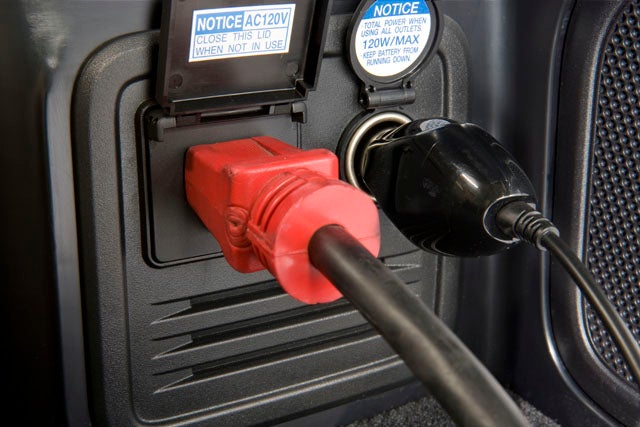 |
| There are connections for both 12-volt and 120-volt power connection in the new 4Runner. |
There are a number of changes to the interior other than newly designed instrumentation. A new Eco-Driving feedback system on the new instrument cluster informs the driver of fuel-efficient operation with a green “ECO” light. The center dash offers useful items such as a compass indicator and outside temperature as well. Passengers in the backseat will be glad to know that the newly sculpted front seat-back is designed for additional knee space. A center armrest has also been added to the rear seat, and second-row seats can recline up to 16 degrees.
Another available feature on the fifth-gen 4Runner is a pull-out cargo deck that will slide out for easy loading. The deck can carry up to 440 pounds and features two pre-set locking positions, and it can function as seating for camping or tailgating as well. The new “party mode” setting is actuated by a switch located near the driver that raises the bass and transfers more sound to the rear of the vehicle, such as the speakers on the rear hatch, for camping or tailgating.
PAGE 3
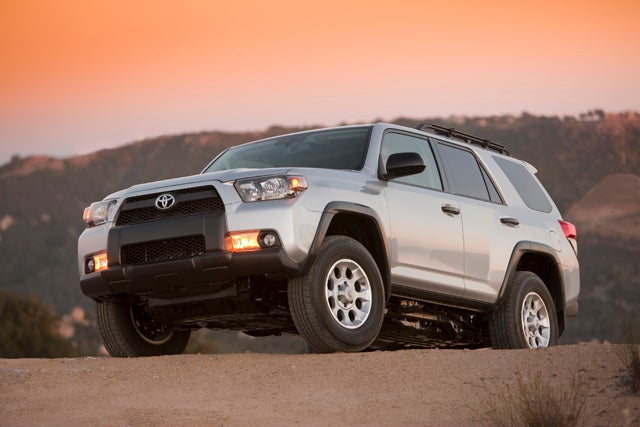 |
| We first thought the 4Runner's new styling was plain, but we quickly came to really like the new look of the fifth-gen 4Runner. Shown is the Trail version, which a different wheel style from the SR5. |
First Impressions
We have to admit that at first glance we weren’t altogether blown away by the look of the new 4Runner. It just looked a little plain. But after just a short time with the fleet of new vehicles, the new look really started to grow on us. From a male perspective, the styling changes Toyota made for the fifth-generation are welcome, and it’s clear both from talking to Toyota representatives and reading the press material that designers were looking to toughen up the look a bit. Sharper lines in select areas and more boxy design elements help give it this look, such as the square front fender flares and rear bumper. Even the stereo and AC knobs inside are larger to help give the interior a little more of a brawny feel. Overall, the new 4Runner is also a little taller, wider and longer than the fourth generation.
Each version (SR5, Trail, Limited) has its own unique wheel design, and the Limited version features a larger 20-inch wheel for drivers who might be looking for more on-road comfort, while the SR5 and Trail version feature a smaller 17-inch wheel for both on and off-road capabilities.
| Toyota took the 4Runner through the Rubicon in an effort to "break" it to find any flaws. The vehicle made it through with no issues, and the only changes were more aggressive tires and rock rails. |
When it comes to driving the new 4Runner, we have to say we don’t miss the V8 motor after driving the new V6. It has plenty of “get up and go” to climb hills, accelerate through turns, and it feels fully capable of towing anything within its 5000-pound capacity. The on-road handling of the 4Runner is great. The 4Runner has always straddled the line between part truck, part SUV. But refinements over the year to the vehicle have made it even more comfortable for on-road operation, and we didn’t feel there were any areas it lacked for on-road driving.
Toyota did not have any of its four-cylinder versions at the press event, though we can’t say were dying to get into one. For buyers looking to get a new 4Runner with a lower sticker price (the 4-cyl. version is just under $1700 less than the V6) then this is the best bet, but for us the fuel savings are so minimal it’s not worth skipping out on the new V6 motor (or losing the 113 horsepower!).
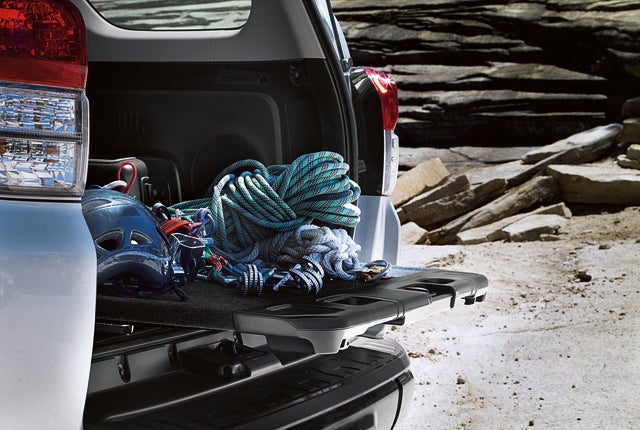 |
| New for 2010, the 4Runner offers a pull-out storage tray for loading and unloading gear. |
For off-road operation, we didn’t get to really put the new 4Runner through its paces as we would have liked. But that wasn’t Toyota’s fault, because believe it or not, California had a pretty solid storm during our introduction that washed out the main trail we planned to tackle. Rain and mud sounds like a good combo for really testing it though, right? We thought so too, but the property owners weren’t thrilled with the idea of us tearing up their roads, so we were limited with our options.
We did, however, get to run it through some mud and on some dirt roads, testing the 4x4 capability and trying out a few of the features like Crawl and Multi-Terrain Select. Though the 4Runner has become more refined over the years, it certainly hasn’t lost its off-road capability. The on-the-fly four-wheel drive button makes it easy to switch out of two-wheel drive when the conditions require it, and there’s no real area of weakness we found with its 4x4 capabilities.
PAGE 4
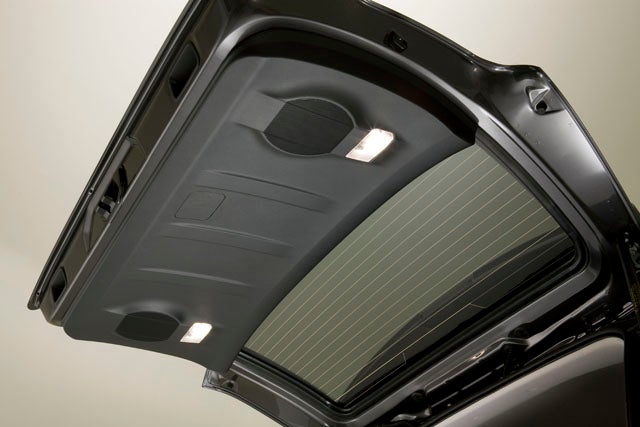 |
| With the push of a button in the front, the bass raises and the speakers shift more sound to the rear to provide more sound for the rear gate speakers for tailgating or camping. |
We tried the Crawl function of the Trail model both on the road and off, and it’s clear this option will be useful for drivers who don’t want to worry about the gas-break-gas movements on rough terrain. By adjusting the dial on the overhead instrument panel, the speed at which the 4Runner travels (or “crawls”) can increase or reduce depending upon the conditions or the driver’s comfort level. It actuates the braking and throttle, so literally the driver can takes his or her foot off the pedals and just steer the vehicle. This feature only functions in low gear, so it’s nothing that you’ll accidentally mess with at higher speed because it won’t even operate.
The Multi-Terrain Select is something we toyed with a little bit. We set it to the mud/sand setting to allow for more wheel spin, and it was noticeable that the wheel spin was increased. Unfortunately, we were not able to test the other settings, but we’re hoping to get our hands on a 4Runner soon to give these new functions a little more of a true test. Hopefully we’ll have a little more to report soon.
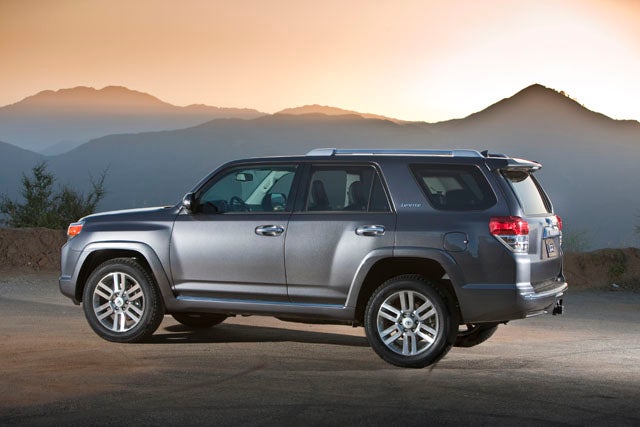 |
| The SR5 and Trail version feature 17-inch wheel, while the Limited version has larger 20-inch wheels. |
Overall, we are impressed with the new 4Runner. Over the years, the 4Runner has moved a little more away from the truck side and focused more on the comfort that so many SUV-type vehicles provide. But while the 4Runner is more refined in many respects, it still has great off-road capability, and that’s really what this vehicle is designed to do – provide a nice, comfortable ride on the road and still have the ability to get dirty on the trails.
The Limited version is available for those looking for all the bells and whistles, but it might not be the first choice for off-roaders. The Trail is really focused for someone who spends a lot of time in the dirt, sand or mud. Trail has a number of features that really offer a level of fine-tuning for off-road conditions that is not often found on production vehicle. Sure, hard-core off-roaders might not use some of the functions, but they all have their place and only aid in driving on the trail. The SR5 is a great option for those looking to get a 4x4 that’s nicely equipped but isn’t fully loaded. If a 4x4 isn’t in store for you, we’d still lean toward the SR5 V6 – the $1675 sticker price saving just doesn’t justify the loss of horsepower considering the fuel saving is so minimal. The starting prices for each model are as follows:
SR5 2WD 4-cyl. - $27,500
SR5 2WD V6 - $29,175
SR5 4WD V6 - $30,195
Trail 4WD V6 - $35,700
Limited 2WD V6 - $37,765
Limited 4WD V6 - $39,800


 Your Privacy Choices
Your Privacy Choices